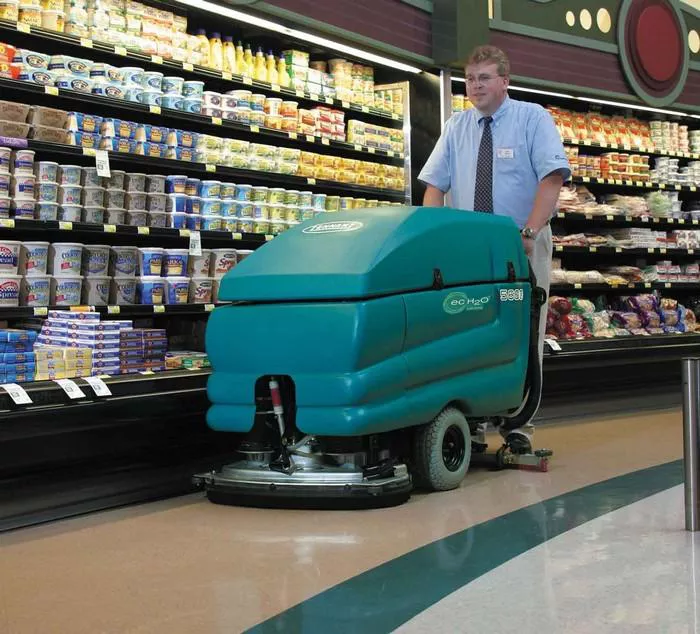Maintaining a clean and safe environment in a variety of settings, such as industrial facilities, commercial spaces, and even residential locations, requires regular floor cleaning. Renowned cleaning equipment maker Tennant Company provides a selection of floor scrubbers made to effectively clean all kinds and sizes of floors. We’ll go into detail about how to use a Tennant floor scrubber efficiently in this thorough tutorial.
I. Understanding Your Tennant Floor Scrubber
You should become familiar with the particular Tennant floor scrubber model that you will be utilizing before delving into the operating intricacies. Tennant provides a range of floor scrubbers, each with special qualities and functions. Get acquainted with the Tennant user manual that corresponds to your particular model. Observe the operating rules, maintenance procedures, and safety recommendations included in the handbook.
II. Preparing the Work Area
1. Clear the Area: Remove any obstacles, debris, or loose objects from the floor to prevent interference with the scrubbing process and ensure safety.
2. Inspect the Floor: Check the floor surface for any significant stains, spills, or buildup. Pre-treating these areas with appropriate cleaning solutions may be necessary for optimal results.
3. Ensure Proper Ventilation: If working indoors, ensure adequate ventilation to dissipate fumes from cleaning solutions and promote a comfortable working environment.
III. Preparing the Tennant Floor Scrubber
1. Inspect the Machine: Before operation, visually inspect the floor scrubber for any signs of damage or malfunction. Check for loose or damaged parts and ensure all components are securely in place.
2. Fill the Solution Tank: Depending on the model, fill the solution tank with the appropriate cleaning solution and water mixture as recommended by Tennant. Use only approved cleaning solutions compatible with your floor scrubber to avoid damage.
3. Adjust Settings: Adjust any operational settings on the floor scrubber, such as brush pressure, water flow rate, and scrubbing mode, to suit the specific requirements of the cleaning task and the type of flooring.
IV. Operating the Tennant Floor Scrubber
1. Start the Machine: Turn on the floor scrubber using the designated power switch or key. Allow the machine to initialize and ensure all systems are functioning correctly before proceeding.
2. Begin Scrubbing: Engage the scrubbing action by lowering the brushes or pads onto the floor surface. Start from one corner of the room and work your way systematically across the area, overlapping each pass slightly for thorough coverage.
3. Control Movement: Depending on the model, maneuver the floor scrubber using the joystick or control panel. Maintain a steady pace to ensure uniform cleaning without missing any spots.
4. Address Stubborn Stains: For stubborn stains or heavily soiled areas, pause the scrubbing motion and focus the cleaning action on the affected area. Increase brush pressure or apply additional cleaning solution if necessary.
5. Monitor Solution Levels: Keep an eye on the solution level in the tank and refill as needed to maintain consistent cleaning performance throughout the operation.
V. Post-Scrubbing Procedures
1. Inspect the Results: Once the entire area has been scrubbed, inspect the floor surface for cleanliness and any remaining stains or debris. Spot-clean any missed areas manually if necessary.
2. Empty and Rinse Tanks: After use, empty the solution and recovery tanks and rinse them thoroughly to remove any residue. Follow the manufacturer’s instructions for proper tank maintenance and cleaning.
3. Clean Brushes or Pads: Remove and clean the brushes or pads used for scrubbing according to the manufacturer’s guidelines. Proper maintenance of these components ensures optimal performance and longevity of the floor scrubber.
4. Store Properly: Once cleaned and dried, store the Tennant floor scrubber in a designated area away from direct sunlight and extreme temperatures. Ensure all power sources are disconnected, and safety measures are in place to prevent accidents.
VI. Safety Considerations
1. Personal Protective Equipment (PPE): Wear appropriate PPE, including safety goggles, gloves, and closed-toe shoes, when operating a Tennant floor scrubber to protect against potential hazards such as splashes, slips, and falls.
2. Follow Safety Guidelines: Adhere to all safety guidelines provided by Tennant and outlined in the user manual. Avoid operating the floor scrubber on wet or slippery surfaces to prevent accidents.
3. Emergency Procedures: Familiarize yourself with emergency shutdown procedures and how to respond to unexpected situations such as equipment malfunction or spills.
VII. Troubleshooting Tips
1. Machine Not Starting: Check the power source and ensure all connections are secure. Inspect the power switch and fuse for any issues.
2. Inadequate Cleaning Performance: Adjust operational settings such as brush pressure and solution flow rate to optimize cleaning performance. Ensure proper maintenance of brushes or pads for effective scrubbing action.
3. Leaks or Drips: Inspect hoses, fittings, and tanks for any signs of leakage. Tighten connections or replace damaged components as needed to prevent solution leakage.
4. Brushes Not Rotating: Check for obstructions or debris hindering the rotation of brushes. Clean or replace brushes if they are worn out or damaged.
Conclusion
Effective Tenant floor scrubber operation necessitates following the right setup, use, and maintenance protocols. You may get the best cleaning results and maintain the durability and dependability of your floor scrubber by following the instructions in this handbook and paying attention to safety precautions. To enhance efficiency and reduce downtime, equipment must undergo routine maintenance and periodic inspections.

